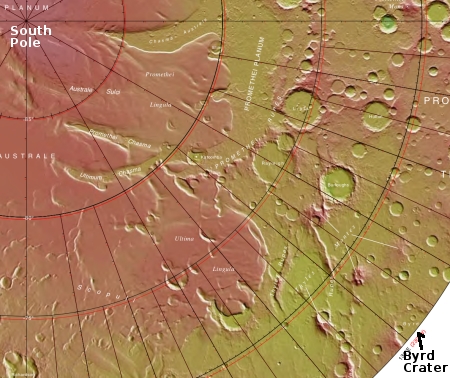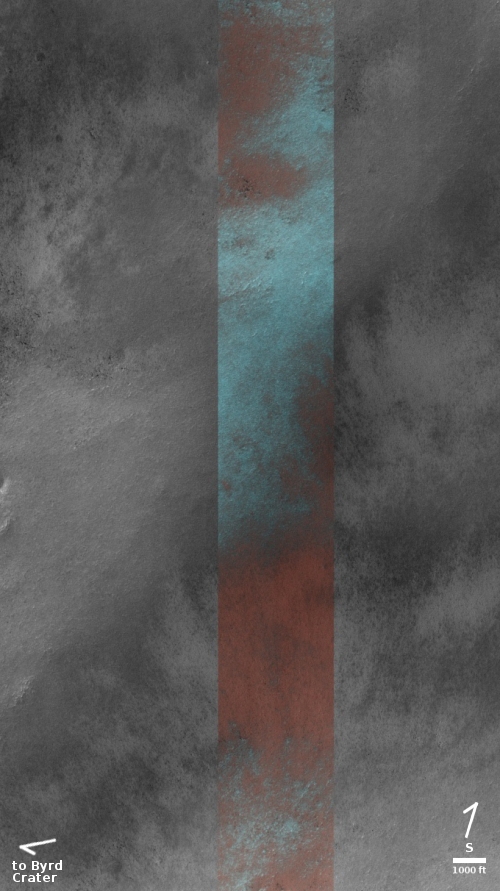The colors of Mars
Actually today’s cool image tells us less about the real colors on Mars and much about the colors captured by the high resolution camera on Mars Reconnaissance Orbiter (MRO). The photo on the right was taken on May 2, 2020, and shows a relatively featureless area to the east of 80-mile wide Byrd Crater in the high southern latitude of Mars.
The only major features seen on this photo are a series of rounded ridges that in the larger context map at the image site look almost like drainage hollows coming down from the crater’s rim about twenty miles away.
The colors, though exaggerated and not entirely as the eye would see them, still tell us something very real about the surface. As explained here [pdf]:
In spite of the variable level of color enhancement for the Extras products, we can make some generalizations to better understand what the stretched color images are showing. Dust (or indurated dust) is generally the reddest material present and looks reddish in the RGB color. … Coarser-grained materials (sand and rocks) are generally bluer … but also relatively dark, except where coated by dust. Frost and ice are also relatively blue, but bright, and often concentrated at the poles or on pole-facing slopes. Some bedrock is also relatively bright and blue, but not as much as frost or ice, and it has distinctive morphologies.
Thus, this photo is telling us that the lower areas are covered with dust (the red), while the rounded ridgelines are covered with coarser and bigger rocks. The brightest blue, which is facing towards the south pole, might also indicate frost or ice.

The map to the right provides the overall context. Today’s image is just off the edge of the map, to the east of Byrd Crater. At about 65 degrees south latitude, Byrd Crater is still quite a distance from the pole, though the edge of the pole’s layered deposits of ice (as shown by the reddish plateau) are only about 200 miles away. Finding ice here would thus not be surprising.
Though this location’s latitude is at the uppermost edge of the mid-latitude bands where scientists have identified many glacial features, its high latitude close to the south pole means that ice is very likely here, an underground ice table close to the surface. Though this is not confirmed, this is what the blue colors are suggesting.
On Christmas Eve 1968 three Americans became the first humans to visit another world. What they did to celebrate was unexpected and profound, and will be remembered throughout all human history. Genesis: the Story of Apollo 8, Robert Zimmerman's classic history of humanity's first journey to another world, tells that story, and it is now available as both an ebook and an audiobook, both with a foreword by Valerie Anders and a new introduction by Robert Zimmerman.
The print edition can be purchased at Amazon or from any other book seller. If you want an autographed copy the price is $60 for the hardback and $45 for the paperback, plus $8 shipping for each. Go here for purchasing details. The ebook is available everywhere for $5.99 (before discount) at amazon, or direct from my ebook publisher, ebookit. If you buy it from ebookit you don't support the big tech companies and the author gets a bigger cut much sooner.
The audiobook is also available at all these vendors, and is also free with a 30-day trial membership to Audible.
"Not simply about one mission, [Genesis] is also the history of America's quest for the moon... Zimmerman has done a masterful job of tying disparate events together into a solid account of one of America's greatest human triumphs."--San Antonio Express-News
Actually today’s cool image tells us less about the real colors on Mars and much about the colors captured by the high resolution camera on Mars Reconnaissance Orbiter (MRO). The photo on the right was taken on May 2, 2020, and shows a relatively featureless area to the east of 80-mile wide Byrd Crater in the high southern latitude of Mars.
The only major features seen on this photo are a series of rounded ridges that in the larger context map at the image site look almost like drainage hollows coming down from the crater’s rim about twenty miles away.
The colors, though exaggerated and not entirely as the eye would see them, still tell us something very real about the surface. As explained here [pdf]:
In spite of the variable level of color enhancement for the Extras products, we can make some generalizations to better understand what the stretched color images are showing. Dust (or indurated dust) is generally the reddest material present and looks reddish in the RGB color. … Coarser-grained materials (sand and rocks) are generally bluer … but also relatively dark, except where coated by dust. Frost and ice are also relatively blue, but bright, and often concentrated at the poles or on pole-facing slopes. Some bedrock is also relatively bright and blue, but not as much as frost or ice, and it has distinctive morphologies.
Thus, this photo is telling us that the lower areas are covered with dust (the red), while the rounded ridgelines are covered with coarser and bigger rocks. The brightest blue, which is facing towards the south pole, might also indicate frost or ice.

The map to the right provides the overall context. Today’s image is just off the edge of the map, to the east of Byrd Crater. At about 65 degrees south latitude, Byrd Crater is still quite a distance from the pole, though the edge of the pole’s layered deposits of ice (as shown by the reddish plateau) are only about 200 miles away. Finding ice here would thus not be surprising.
Though this location’s latitude is at the uppermost edge of the mid-latitude bands where scientists have identified many glacial features, its high latitude close to the south pole means that ice is very likely here, an underground ice table close to the surface. Though this is not confirmed, this is what the blue colors are suggesting.
On Christmas Eve 1968 three Americans became the first humans to visit another world. What they did to celebrate was unexpected and profound, and will be remembered throughout all human history. Genesis: the Story of Apollo 8, Robert Zimmerman's classic history of humanity's first journey to another world, tells that story, and it is now available as both an ebook and an audiobook, both with a foreword by Valerie Anders and a new introduction by Robert Zimmerman.
The print edition can be purchased at Amazon or from any other book seller. If you want an autographed copy the price is $60 for the hardback and $45 for the paperback, plus $8 shipping for each. Go here for purchasing details. The ebook is available everywhere for $5.99 (before discount) at amazon, or direct from my ebook publisher, ebookit. If you buy it from ebookit you don't support the big tech companies and the author gets a bigger cut much sooner.
The audiobook is also available at all these vendors, and is also free with a 30-day trial membership to Audible.
"Not simply about one mission, [Genesis] is also the history of America's quest for the moon... Zimmerman has done a masterful job of tying disparate events together into a solid account of one of America's greatest human triumphs."--San Antonio Express-News



False colors of astronomical objects have always been a “necessary evil” in science, but in my experience with star parties, so many of the public are disappointed in not seeing the “pretty colors” like they did in magazines and online. Some conversations would end up with long and drawn out explanations, while others folks would just walk away a bit let down. I started telling folks before they got to the eyepiece the “pretty colors” would not be there, but challenged them to look around and tell me what the =could= see. A fun test was to have the Orion nebula centered and ask them what colors they pick out. The younger kids (with more color sensitivity) got a kick out of seeing more than the parents.